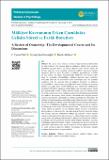DSpace Repository
A Review of Ownership: The Developmental Course and Its Dimensions
- DSpace Home
- →
- Web Of Science
- →
- Web Of Science
- →
- View Item
JavaScript is disabled for your browser. Some features of this site may not work without it.
| dc.contributor.author | Pala Dedeoğlu, Fatma Cansu
|
|
| dc.date.accessioned | 2024-03-22T11:44:07Z | |
| dc.date.available | 2024-03-22T11:44:07Z | |
| dc.date.issued | 2021 | |
| dc.identifier.issn | 1304-4680 | |
| dc.identifier.issn | 2602-2982 | |
| dc.identifier.uri | http://hdl.handle.net/11547/11395 | |
| dc.description.abstract | Ownership is a relation of belonging between a person and an object that is accepted by other people. Knowing to whom an object belongs allows children to differentiate between what is theirs and what is not. This review aims to explore the development processes of ownership during early childhood. the basic dimensions of the concept of ownership, and the relationship of ownership development with language and culture. The multidimensional structure of ownership includes the kinds of objects that are owned, how ownership decisions are made, and how property rights and privileges are transferred. Most two-year-olds can recognize who owns an object and determine ownership. but only after the fifth birthday can children determine an owner not by desire but by transfer rules. In studies reporting developmental differenetz in ownership, the effect of age is strikingly inconsistent. However, ownership should be addressed in early childhood within the scope of rapidly changing social cognitive processes. A child needs to understand the abstract relationship between an object and an individual and represent that relationship in their mind. Therefore, this review study discusses whether self-development. mental representation. and other cognitive abilities are among the underlying factors of ownership. In addition, the possible effects of language and culture on ownership, both directly and cognitively, are also mentioned. Although ownership is exciting in social structure and in built-upon cognitive skills recognized in the literature, its development and constituent elements have yet to be examined sufficiently. Understanding ownership's developmental pattern might illuminate meaning attributed to ownership and objects (extended-self hypothesis). Since no research has addressed this concept in a Turkish sample to date, this review aims to introduce the notion of ownership, its developmental characteristics, and its basic structures for researchers in the field. | tr_TR |
| dc.language.iso | tr | tr_TR |
| dc.relation.ispartofseries | 41;2 | |
| dc.subject | THEORY-OF-MIND | tr_TR |
| dc.subject | EXECUTIVE FUNCTION | tr_TR |
| dc.title | A Review of Ownership: The Developmental Course and Its Dimensions | tr_TR |
| dc.type | Article | tr_TR |
Files in this item
This item appears in the following Collection(s)
-
Web Of Science [1069]
